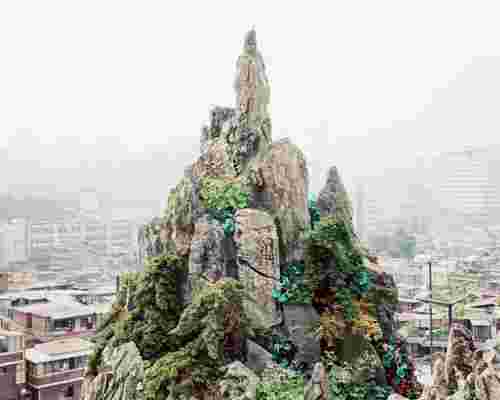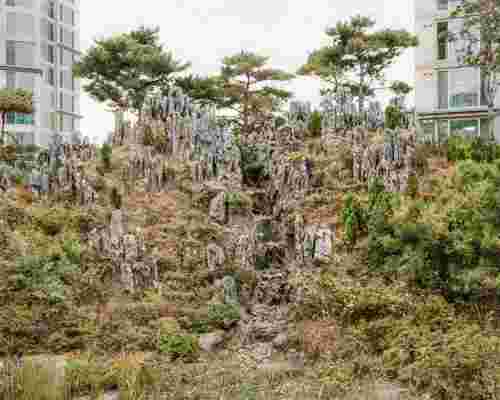According to myth and tradition, the first Korean people were led out of the mountains by the God-king Dangun around 2300 BCE; the peninsula’s mountains have been the country’s spiritual center ever since. Certain peaks are sacred, such as Paektu Mountain in North Korea, known as Changbai Mountain in China, which straddles the border between the two nations. This is a holy site for both North and South Koreans, and North Korean propaganda also claims that Kim Il Sung was born on the mountain.
In the high-end residential districts of Seoul, South Korea, another kind of mountain can be seen rising among apartment buildings and gated communities. These are replicas of some of Korea’s most famous natural sites, rendered in miniature for the enjoyment of the city’s rising upper class. Dubbed jingyeong sansu, this trend of reproducing famous landscapes, such as the Dodamsambong Peaks , has been around for about 10 years, according to Seunggu Kim, a Seoul-based photographer who has documented the upper classes’ interest in reproducing natural beauty.

Much of the Korean history comes from the mountains developers are now mimicking to lure wealthy buyers to their new urban apartment buildings.
According to Kim, jingyeong sansu is popular among property developers building apartments for the wealthy because it adds to the building’s feng-shui—and property values rise accordingly. Developers have used the artificial peaks as a way to tap into the nation’s mountain-loving soul, adding to their constructions slogans like “Mt. Geumgang has the force that makes everything alive in the world,” and “Mt. Seorak is the cradle of divine life.”

The scenes of famous natural landmarks add feng-shui to an otherwise strictly urban environment.
It’s a way to draw a connection between traditional Korean spirituality and luxury consumerism, and though the artificial mountains are replicas of sites considered sacred by many Koreans, there is something universal about their appeal. In heavily developed Seoul, any splash of green is a welcome one, and these constructions offer a brief—mostly visual and spiritual—respite from the hustle and bustle of a major urban center.
The ultimate resource for design industry professionals, brought to you by the editors of Architectural Digest

According to Kim, the phrase “jingyeong sansu” is a traditional Korean term for the continuous observation of nature that produces a harmony with the natural world. The roots of the style are in 18th-century Korean landscape painting , when artists who had previously depicted idealized landscapes began to turn their attention to the Korean landscape as it actually was, and strove to recapture the exact qualities of real mountains and landscapes in the country. This style was similarly dubbed jingyeong sansuhwa, which roughly translates to “true-view landscape painting.”
A family sits inside a room overlooking one of the fabricated famous landmarks in the Korean peninsula.
The impulse that drives luxury property owners in Seoul to re-create a spiritually significant mountain in miniature scale in their building’s courtyard is not so far off from the impulse that drove romantic landowners in 19th-century England to erect faux Greco-Roman ruins in their gardens. Both types of folly are an expression of the owners desire to connect their gray, quotidian urban existence to an imagined pastoral past.
Kim notes that jingyeong sansu is more deeply rooted in traditional spirituality. “We can in some way see the spiritual values of the past in modern cities,” he says, telling AD that city dwellers of means yearn for an almost shamanistic connection to the natural world that isn’t present in urban life. Creating replica mountains is a way to harness that spirituality, as well as make nature yet another amenity for urban dwellers.
